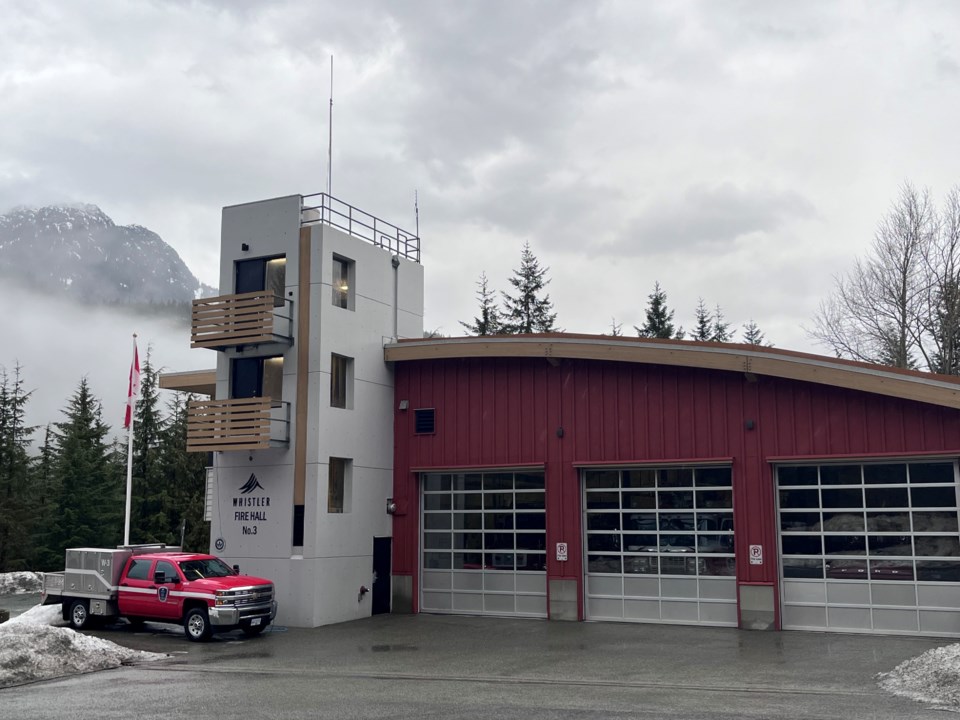The Resort Municipality of Whistler (RMOW) will pay to staff Fire Hall No. 3 as soon as practical to the tune of up to $555,000 in 2024, with that number rising to more than $2 million per year by 2026.
Fire Hall No. 3 is located at 1505 Spring Creek Drive, serving the southern part of the community, and is currently assigned a paid-on-call crew, rather than full-time staff.
The change in staffing was initially requested as a late item during the 2024 budget process, but was pulled from the budget after council requested a more fulsome report, which was delivered at the Jan. 23 council meeting.
In a presentation giving background on the rationale for recommending the increase in firefighter staffing, the RMOW’s general manager of corporate services and public safety, Ted Battiston, explained the community has grown significantly since 2003, when Whistler last reviewed its “posture” of where firefighting resources were allocated between its three fire halls.
He said Whistler grew by more than 20 per cent between 2015 and 2020 alone, but the population estimate of the community doesn’t tell the complete story.
“We all know that Whistler operates in a way that’s not just informed by the number of people who are resident in this community, but by those we call population equivalent (second homeowners, seasonal staff, commuters and day visitors)—and that number has now increased to an average annualized daily population of 42,000,” Battiston said.
And that number is also weighted heavily towards the south—within Fire Hall No. 3’s area.
“What’s important to understand about this growth is that it’s asymmetric within the community—the growth itself is weighted to the south end of the community, and it has been for the last almost 20 years,” Battiston said, explaining the change in staffing structure is about re-balancing firefighting capacity to ensure the same level of service across Whistler.
Along with the population growth, Battiston said call volumes are growing to the south (where more than half of all motor vehicle incidents are occurring), and there is opportunity to decrease fire insurance premiums by increasing staffing.
Whistler’s overall wildfire defense posture can also be improved with the change, and by having a team based out of Hall No. 3, the Whistler Fire Rescue Service (WFRS) could “meaningfully improve emergency response activities for the entire community” by freeing up capacity from the team based out of Fire Hall No. 1, Battiston said.
Currently, Fire Hall No. 1 is staffed 24 hours a day by career firefighters, with 23 full-time career firefighters on the payroll. Fire Hall No. 1 also has a paid-on-call team that is called as needed. Both Fire Hall No. 2 and Fire Hall No. 3 have only paid-on-call responders (of which there are between 50 and 60 with WFRS), but all three halls are fully equipped.
Battiston recommended the RMOW phase-in staffing over three years, beginning “as soon as practicable” in 2024 (forecast to be May) in a 12-hour shift model, followed by a full year of that model in 2025, and then 24-hour staffing from 2026 onwards.
The number of firefighters actually employed would be four permanent full-time plus a relief firefighter to cover 12-hour shifts for two people 365 days a year.
Costs covering payroll, training and uniforms were estimated to be up to $555,000, assuming staffing from May 1 through to the end of 2024, with that cost increasing to up to $1,071,200 in 2025 (due to the 12-month estimate), and then up to $2,206,672 in 2026 due to 24-hour staffing, and $2,272,872 from the next year onwards.
Overall, the number of full-time career staff with WFRS would increase to 28 with the staffing of Fire Hall No. 3.
Battiston reported the impact on taxes would be an additional one per cent in 2025, and 2.06 per cent in 2026 if the staffing model was adopted as proposed.
On an individual level, that washes out to an additional $13 per million dollars of assessed property value in 2025, and $30 per million dollars of assessed property in 2026, but Battiston added that from 2026 onwards, the RMOW expects there would be a reduction in fire insurance premiums “equal to 30 to 50 per cent of the increased property tax costs across the community.”
During questions and comments from council, the ongoing impact of such a change was noted, and weighed against the threat of wildfire and need for well-funded and resourced emergency services in the face of the rising number of calls, growing community population and the threat of wildfire.
Council voted to accept the staff recommendation as proposed, with an amendment that staff bring back a report on how the change in staffing is working before the end of the year. The changes will be incorporated into the five-year financial plan for 2024-2028. The full presentation can be watched on the RMOW website (beginning at 3:18:52).




